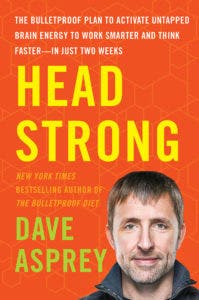Blazing a Trail to Age 180

Dave Asprey’s insights and life hacks reach well beyond Bulletproof coffee.

At the time, Asprey asked a doctor why he felt so terrible despite his efforts. That doctor’s suggestion that Asprey lose some weight—the very reason Asprey had been dieting and exercising—was the turning point for a personal journey that’s now a professional pursuit of ways to take charge of our bodies and unlock the secrets of human health, performance and longevity. “Head Strong,” his latest book due out in April, distills his latest findings into a two-week program of mental, physical and nutrition hacks that can help support cellular health that is the basis for aging (or not).

Based on his findings so far, Asprey is working to live to 180 (or more). He recently took 24Life Editor Lashaun Dale on a tour of his lab to discuss his strategies, insights and experiences with her.
Lashaun Dale (LD): Let’s start with what you do: biohacking. What is that?
Dave Asprey (DA): In my career as a Silicon Valley entrepreneur, I’ve had the chance to run corporate strategy and strategic planning for several different companies worth more than $1 billion. And when you’re doing strategy, you actually do think about the entire environment around you, and then you think about what you’re doing in the environment. … When you can change your actions so the environment changes, which then has a feedback loop, that’s how you can get a strategic advantage.
The important thing to understand about strategy, though, is that there are lots of variables where you don’t have full knowledge and you don’t have full control. What you do have full control of is yourself, and you have some degree of control of the environment around you. So something as simple as exercise changes the signal from the environment into your body. So exercise is a good strategy, but doing the type of exercise that works best for you in the least possible time is an even more efficient strategy. It’s the same thinking that drives these big companies that can drive you to get more control over your own biology.
Biohacking is the art and science of changing the environment around you so you have more control over your own biology. … Your body does all sorts of things you don’t want. It gets distracted, it gets fat, and it gets tired and things start to sag. Well, don’t you want to hack that system? Don’t you want to take control of it, and is it OK to take control of it even if you don’t know everything about how it works? It’s not only OK—that’s what we’re wired to do as human beings. And that’s why I’m completely happy to be hacking myself. It’s not cheating. It means doing the most effective things to get the results we want.
LD: And when you think about hacks, are they short-term or long-term strategies?
DA: There are two ways to think about hacks. One is, if you’re trying to create a specific change in your body, that’s a new regimen of focus, attention, so you might start tracking something much more tightly. You want better sleep, then you’re going to look at monitoring your sleep. You want more efficient exercise, then you’re going to look at monitoring your exercise and the results you get from the exercise. Those are short-term hacks.
But the best hacks are the ones where you make one change that has a permanent effect—you don’t have to think about it anymore. So one of the hacks I’m most fond of is getting rid of LED lightbulbs in your house because [research suggests that] those suppress [the sleep hormone] melatonin much more than halogen or incandescent lightbulbs. … So the hack I used was to replace my lightbulbs with more natural spectrum, non-fluorescent, non-LED lights. … That’s a long-term hack that didn’t really take a lot of energy to do, I did it one time and it has permanent benefits.
LD: Your Bulletproof coffee has gotten a lot of attention, but what’s the premise underpinning your work?
DA: About 10 percent of your body weight is your battery, believe it or not. You have an iPhone. Your iPhone has a battery that charges everything. You are no different, and you charge your battery by eating and to some extent by getting some sunshine and by breathing. If your battery works really, really well, like it does in a new phone, it holds a charge all day and it works all the time. If your battery just doesn’t hold a charge very well or it doesn’t deliver as much energy as it should, your phone won’t do all the things it’s capable of doing, and you’re exactly the same way.
Your battery is a part of the cell called the mitochondria. In fact, you have a quadrillion of them in your body. They decide how much energy you’re allowed to have, how much energy you’re allowed to have when you’re doing a bench press, and how much energy you’re allowed to have when you’re working to not yell at your kids because they just did something that made you frustrated.
And mitochondria don’t listen to you. They don’t listen to the environment around you. They listen to the stimulus and the demands that are put on them. So when you exercise really vigorously, you’re telling them, “Be ready to be strong, be able to deliver that electricity to my brain cells and to my muscle cells, to my heart.” And when you relax and you meditate or do yoga, what you’re doing is you’re telling them, “The world is not a threatening place. Therefore, take your energy and use it to recharge and refresh the battery system instead of being ready to run away from tigers.” By controlling the environment around you, you can actually make your mitochondria work much better.
In the research for “Head Strong,” I figured out that about 48 percent of people under age 40 have early-onset mitochondrial dysfunction. In other words, their battery is losing a charge earlier than it should, and everyone over age 40 has mitochondrial dysfunction. It’s called aging. My goal is to live to 180 plus, and that’s not a joke. That’s actually achievable. About 120 is achievable with where technology is today. As technology changes, I’m expecting to get more mileage out of the body that I have here. You can do the same thing, and it starts and really ends with taking care of your mitochondria, because when your batteries die, you die.
LD: Does mitochondrial health impact more than your body?
DA: One of the really cool things about mitochondria is that it’s exactly the same battery system that fuels your brain that fuels your heart and your muscles and everything else, your lungs. So I wanted a brain that would work really well. I want to increase my creativity and intuition and my ability to create things with Bulletproof. And the kind of exercise where I’m using my brain and my body at the same time is shown on multiple studies to improve exactly that type of function, so creativity comes from not just exercising but playing, having fun.
If you don’t fail sometimes in your exercise, if you don’t try to lift more than you can lift, you won’t grow. I’m making my brain lift more than it wants to lift. The brain is actually better at avoiding exercise than muscles are. That’s why you’ve got to find new ways to push it, like ping pong, like juggling, [even] hanging upside down. … [What happens is] when gravity shifts and puts blood in your head, your brain will grow new capillaries. The mitochondria in your head function based on the oxygen and fuel carried in your bloodstream.
LD: Mindfulness is an essential aspect of your work—and the health of your brain, the organ, also impacts the health of the mind, right?
DA: The title of “Head Strong” is not about being stubborn. It’s actually about strength in your head. This battery system in your body, your mitochondria, is most represented in your brain. You have more mitochondria in your neurons and in your head and in your eyes and in your heart than anywhere else in your body. What that means is that when you do something to make your body strong [and] make your mitochondria strong, you’re going to feel it first in your head. All of us want more willpower. All of us want more energy. Even if we feel great, you could still use a little bit more energy because you could do more of the things you love. Having strength in your head is one of the most powerful things you can do and sets a whole system’s upgrade of your battery, of your energy production system.
LD: Your lab is full of cutting-edge devices you use to test and replicate theories about human performance. So why is there an antique wooden cabinet in your lab?
DA: One of the things that I’ve learned about mindfulness is that there are all these processes running in the back of your mind that you’re probably not aware of. And one of them is that I don’t have enough. We’re in a scarce environment. Think of single bacterium floating around. Do I have enough? Do I have enough sugar? Do I have enough food? Do I have enough fuel? Am I going to die?
So I sat down and I said, “What are the things that I want to tell my nervous system that I have unlimited amounts of, just on tap?” [and labeled the drawers on the filing cabinet]. This piece of furniture is from 1885. This is the original hard drive. This is what we used before we had iPhones and computers and the cloud and all that stuff.
So if I ever get a message inside of, “Oh, I don’t have enough of X,” I have a cabinet full of it and I can just pull it out. I don’t have to open the cabinet. This is just about knowing that it’s there. This is a hack that everyone can do: Write down what are the things that I want to have in my life, unlimited amounts of, just to believe I have them, so that then I can go forth from a place of abundance instead of fear. I chose things like passion, kindness, peace, creativity, reason, power, science, courage, connection and love, knowledge, control and discovery, and other things like that. These are things that I want in my life, but I want them in my life not because I thought about them but because they’re built in. [The cabinet is] there to remind me of these things. I don’t have to think about it because I already know they’re there.
https://www.youtube.com/watch?v=Dy19kjRs6Yw
Photo credit: Mark Kuroda, kurodastudios.com